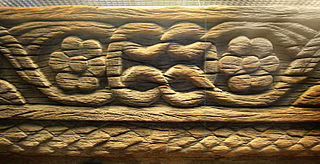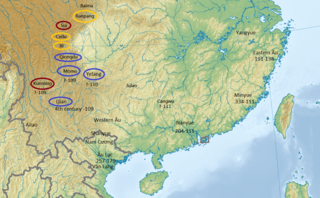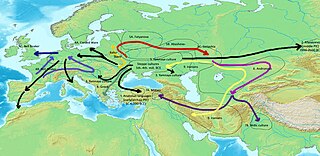
The belt hook is a device for fastening that predates the belt buckle. [1] [2]

The belt hook is a device for fastening that predates the belt buckle. [1] [2]

The earliest archaeological evidence of belt hooks date to the 7th century BCE, in East Asia. [1] Belt hooks were made with bronze, iron, gold, and jade. [1] Texts from Warring States period China claim that the belt hook originates from Central Asian nomads, although belt hooks have been found in China predating the Warring States. [2] The equestrian tradition, initially foreign to China, was tightly related to wearing belted pants, thus belt hooks became one of the features of "barbaric" exoticism. As such, the hooks became an object of aesthetic contemplation. For example, Qu Yuan (c. 340-278 BCE) compares beautiful women to the belt hooks xianbei (鮮卑). [3]
Belt hooks have also been found in Celtic archaeological sites. [4]

A chariot is a type of cart driven by a charioteer, usually using horses to provide rapid motive power. The oldest known chariots have been found in burials of the Sintashta culture in modern-day Chelyabinsk Oblast, Russia, dated to c. 1950–1880 BCE and are depicted on cylinder seals from Central Anatolia in Kültepe dated to c. 1900 BCE. The critical invention that allowed the construction of light, horse-drawn chariots was the spoked wheel.

Ancient history is a time period from the beginning of writing and recorded human history through late antiquity. The span of recorded history is roughly 5,000 years, beginning with the development of Sumerian cuneiform script. Ancient history covers all continents inhabited by humans in the period 3000 BC – AD 500, ending with the expansion of Islam in late antiquity. The three-age system periodizes ancient history into the Stone Age, the Bronze Age, and the Iron Age, with recorded history generally considered to begin with the Bronze Age. The start and end of the three ages vary between world regions. In many regions the Bronze Age is generally considered to begin a few centuries prior to 3000 BC, while the end of the Iron Age varies from the early first millennium BC in some regions to the late first millennium AD in others.

The Silk Road was a network of Eurasian trade routes active from the second century BCE until the mid-15th century. Spanning over 6,400 km (4,000 mi), it played a central role in facilitating economic, cultural, political, and religious interactions between the Eastern and Western worlds. The name "Silk Road" was first coined in the late 19th century, but some 20th- and 21st-century historians instead prefer the term Silk Routes, on the grounds that it more accurately describes the intricate web of land and sea routes connecting Central, East, South, Southeast, and West Asia as well as East Africa and Southern Europe.

The Saka were a group of nomadic Eastern Iranian peoples who historically inhabited the northern and eastern Eurasian Steppe and the Tarim Basin.

The Tocharians or Tokharians were speakers of the Tocharian languages, Indo-European languages known from around 7,600 documents from around AD 400 to 1200, found on the northern edge of the Tarim Basin. The name "Tocharian" was given to these languages in the early 20th century by scholars who identified their speakers with a people known in ancient Greek sources as the Tókharoi, who inhabited Bactria from the 2nd century BC. This identification is now generally considered erroneous, but the name "Tocharian" remains the most common term for the languages and their speakers. Their actual ethnic name is unknown, although they may have referred to themselves as the Agni, Kuči, and Krorän or as the Agniya and Kuchiya known from Sanskrit texts.

The Kingdom of Khotan was an ancient Buddhist Saka kingdom located on the branch of the Silk Road that ran along the southern edge of the Taklamakan Desert in the Tarim Basin. The ancient capital was originally sited to the west of modern-day Hotan at Yotkan. From the Han dynasty until at least the Tang dynasty it was known in Chinese as Yutian. This largely Buddhist kingdom existed for over a thousand years until it was conquered by the Muslim Kara-Khanid Khanate in 1006, during the Islamization and Turkicization of Xinjiang.
The Massagetae or Massageteans, also known as Sakā tigraxaudā or Orthocorybantians, were an ancient Eastern Iranian Saka people who inhabited the steppes of Central Asia and were part of the wider Scythian cultures. The Massagetae rose to power in the 8th to 7th centuries BCE, when they started a series of events with wide-reaching consequences by expelling the Scythians out of Central Asia and into the Caucasian and Pontic Steppes. The Massagetae are most famous for their queen Tomyris's alleged defeating and killing of Cyrus, the founder of the Persian Achaemenid Empire.

Loulan, also known as Kroraïna (Krorayina) in native Gandhari documents or Krorän in later Uyghur, was an ancient kingdom based around an important oasis city along the Silk Road already known in the 2nd century BCE on the northeastern edge of the Lop Desert. The term Loulan is the Chinese transcription of the native name Kroraïna and is used to refer to the city near the brackish desert lake Lop Nur as well as the kingdom.

The Tarim mummies are a series of mummies discovered in the Tarim Basin in present-day Xinjiang, China, which date from 1800 BCE to the first centuries BCE, with a new group of individuals recently dated to between c. 2100 and 1700 BCE. The Tarim population to which the earliest mummies belonged was agropastoral, and they lived circa 2000 BCE in what was formerly a freshwater environment, which has now become desertified.
The Afanasievo culture, or Afanasevo culture, is an early archaeological culture of south Siberia, occupying the Minusinsk Basin and the Altai Mountains during the eneolithic era, c. 3300 to 2500 BCE. It is named after a nearby mountain, Gora Afanasieva in what is now Bogradsky District, Khakassia, Russia, first excavated by archaeologist Sergei Teploukhov in 1920-1929. Afanasievo burials have been found as far as Shatar Chuluu in central Mongolia, confirming a further expansion about 1,500 km beyond the Altai Mountains. The Afanasievo culture is now considered as an integral part of the Prehistory of Western and Central Mongolia.
The Dingling were an ancient people who appear in Chinese historiography in the context of the 1st century BCE.
Victor Henry Mair is an American sinologist currently serving as a professor of Chinese at the University of Pennsylvania. Among other accomplishments, Mair has edited the standard Columbia History of Chinese Literature and the Columbia Anthology of Traditional Chinese Literature. Mair is the series editor of the Cambria Sinophone World Series, and his book coauthored with Miriam Robbins Dexter, Sacred Display: Divine and Magical Female Figures of Eurasia, won the Sarasvati Award for the Best Nonfiction Book in Women and Mythology.

Dian was an ancient kingdom established by the Dian people, a non-Han metalworking civilization that inhabited around the Dian Lake plateau of central northern Yunnan, China from the late Spring and Autumn period until the Eastern Han dynasty. The Dian buried their dead in vertical pit graves. The Dian language was likely one of the Tibeto-Burman languages. The Han Empire's annexation of the Dian Kingdom in 109 BCE eventually led to the establishment of the Yizhou commandery. Dian culture started from at least the 8th century BCE, until it fell under the control of the Han dynasty in 109 BCE.

Metallurgy in China has a long history, with the earliest metal objects in China dating back to around 3,000 BCE. The majority of early metal items found in China come from the North-Western Region. China was the earliest civilization to use the blast furnace and produce cast iron.

The Ordos culture was a material culture occupying a region centered on the Ordos Loop during the Bronze and early Iron Age from c. 800 BCE to 150 BCE. The Ordos culture is known for significant finds of Scythian art and may represent the easternmost extension of Indo-European Eurasian nomads, such as the Saka, or may be linkable to Palaeo-Siberians or Yeniseians. Under the Qin and Han dynasties, the area came under the control of contemporaneous Chinese states.

Ferrous metallurgy is the metallurgy of iron and its alloys. The earliest surviving prehistoric iron artifacts, from the 4th millennium BC in Egypt, were made from meteoritic iron-nickel. It is not known when or where the smelting of iron from ores began, but by the end of the 2nd millennium BC iron was being produced from iron ores in the region from Greece to India, The use of wrought iron was known by the 1st millennium BC, and its spread defined the Iron Age. During the medieval period, smiths in Europe found a way of producing wrought iron from cast iron, in this context known as pig iron, using finery forges. All these processes required charcoal as fuel.

Prehistory, also called pre-literary history, is the period of human history between the first known use of stone tools by hominins c. 3.3 million years ago and the beginning of recorded history with the invention of writing systems. The use of symbols, marks, and images appears very early among humans, but the earliest known writing systems appeared c. 5,200 years ago. It took thousands of years for writing systems to be widely adopted, with writing having spread to almost all cultures by the 19th century. The end of prehistory therefore came at different times in different places, and the term is less often used in discussing societies where prehistory ended relatively recently.
The Jushi, or Gushi, were a people probably associated with the Subeshi culture, who established a kingdom during the 1st millennium BC in the Turpan basin. The kingdom included the area of Ayding Lake, in the eastern Tian Shan range. During the late 2nd and early 1st century BC, the area was increasingly dominated by the Han dynasty and the northern neighbours of the Jushi, the Xiongnu, and became one of the many minor states of the Western Regions of Han dynasty China. In 450 AD the Northern Liang destroyed the state of Jushi (車師) and occupied its capital city of Jiaohe 交河 (Yarkhoto). Jiaohe, later known as Yarkhoto and Yarghul, was destroyed in a Mongol attack in the 13th century.

The Indo-European migrations are hypothesized migrations of Proto-Indo-European language (PIE) speakers, and subsequent migrations of people speaking derived Indo-European languages, which took place approx. 4000 to 1000 BCE, potentially explaining how these languages came to be spoken across a large area of Eurasia, spanning from the Indian subcontinent and Iranian plateau to Atlantic Europe, in a process of cultural diffusion.

The Yanbulaq culture was an ancient culture based on the tombs of the Yanbulaq Cemetery located on the northern hills of the Qumul Basin, in Yizhou District, Xinjiang, China. It was a Bronze Age culture, or an early Iron Age culture.